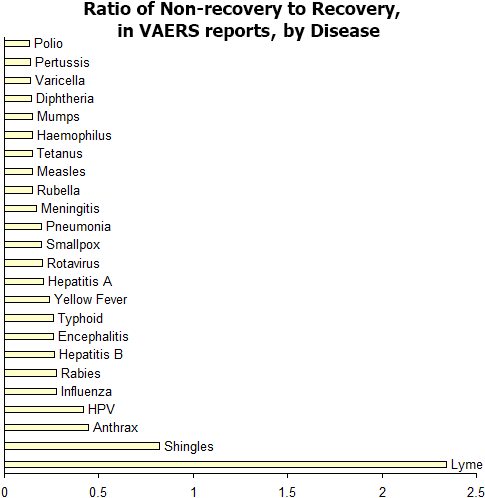
Information Center
Your Health. Your Family. Your Choice.
 |
National Vaccine Information Center Your Health. Your Family. Your Choice. |
The MedAlerts Blog |
Every VAERS report includes a number of factors about how the patient fared. Were they hospitalized? Was the reaction life threatening? Did they die?
This month, I want to look at the outcome called "Recovery" which asks whether the patient was able to get past the adverse reaction, or whether they suffered something permanent (even death).
Two factors affect the Recovery status of a VAERS report, one which makes the factor appear more than it should, and one which makes the factor appear less than it should. The factor that makes Recovery appear more often than it should is the simple fact that some reports are made early in the progress of a case, when recovery has not yet happened. There is no formal mechanism for following-up on VAERS reports, and although some people do provide updates, many do not. Therefore, some non-recovery reports are merely reports that never got updated to show that recovery did happen.
The factor which makes Recovery appear less than it should is that many long-term reactions do not show up at the time of the VAERS report, and it is sometimes impossible to determine a linkage between a long-term effect and a vaccination. This is especially true of vaccines given to infants, where the patient cannot give a sufficient report, and the parents may not notice the long-term effect.
Ignoring the inaccuracies in VAERS data, let's take a look at the Recovery data. It is very easy to find out this information. Simply make a table of Vaccine Type and Recovered. The table shows, for every disease type that can be vaccinated against, the number of reports where the patient did or did not recover (sometimes this factor is unknown). Some diseases have so few reports, that it is not meaningful to look at the recovery information: those diseases have been removed from consideration. Here is the remaining data:

|
|
|||||||||||||||||||||||||||||||||||||||||||||||||||||||||||||||||||||||||||||||||||||||||||||||||||||||||||||
The worst offender is the vaccine for Lyme Disease, where only 466 events showed a recovery, and more than twice as many, 1092 did not recover. Thankfully, this vaccine was pulled from the market.
The next three vaccines on the list show a stronger inclination toward nonrecovery: Shingles, Anthrax, and HPV. The Shingles vaccine is troublesome, as the January, 2013 blog entry describes. The Anthrax vaccine has also been discussed in the May, 2012 blog entry.
The HPV vaccine has all sorts of problems with it, as has been discussed in many previous blog entries (April, 2013, Nov, 2011, Oct, 2011, August, 2011, Nov, 2010, Dec, 2009). The manufacturer states on the product insert that the typical reactions associated with this vaccine are fever, injection site sensitivity, and other short-lived problems. However, VAERS data shows that nearly a third of the people who file VAERS reports following an HPV vaccine did not recover (and 139 have died). These are not minor reactions.
So if you are considering getting a Shingles, Anthrax, or HPV vaccine, you should discuss these issues with your doctor and make an informed decision.
Copyright ©
2025 National Vaccine Information Center. All rights reserved.
21525 Ridgetop Circle, Suite 100, Sterling, VA 20166